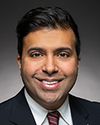Sure. In Canada, we have a number of groups that pose a risk to us, and I don't mean the groups that were designated on the terrorist watch-list: Proud Boys, for example. Proud Boys Canada were not really involved in violent acts, but it's th other groups that we might not be aware of as well as we should be.
Some years ago, I think it was VICE News that did a piece on an anti-Muslim militia out in Alberta. They were openly posing with firearms. They made very clear their statements of hating Muslims and being ready to take up arms against what they saw as the invasion of Muslims in Canada.
There were a lot of questions at the time on why these people weren't being arrested, and I'm pretty sure that there are active investigations ongoing in that regard. However, these are the kinds of groups that worry me and are real threats to public safety.
More recently we saw the emergence of supposedly a group that started out as a joke, Diagolon. It's made up of former members of the Canadian Forces, individuals with real combat training, with real capabilities and who have grown increasingly radicalized, especially because of COVID. These are people with weapons. There is an alleged connection between this group and the group that was arrested at the Coutts border crossing, who were ready to engage police in a firefight, in a shootout.
These are the kinds of groups that I consider to be a real and significant threat to Canadian public safety at large.





